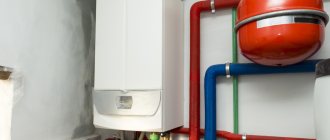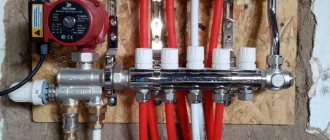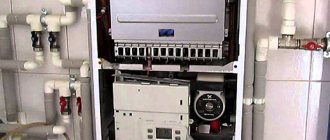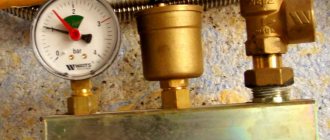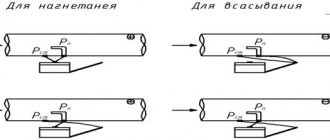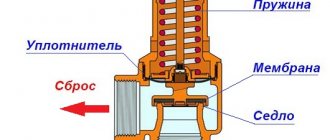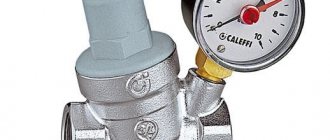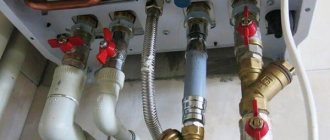Hi all! The author of the site Blogvp.ru, Vitaly, is in touch! I think you will agree that it is not a very fun experience to be left without heating and hot water on winter days. And this prospect came up several times in my house. I want to tell you how I struggled with this and what knowledge I acquired in this matter.
In my house, a gas double-circuit wall-mounted boiler ARISTON CLAS 24 FF is working to create comfort. Undoubtedly, the thing is extremely convenient; anyone who used, for example, geysers from the early nineties will understand.
But, as they say, nothing lasts forever, and therefore sooner or later, you have to deal with the refusal of technology to perform the intended work. In this article we will look at problems with pressure in the boiler, namely two types of this problem.
- When the pressure just keeps dropping.
- Cases when the pressure fluctuates, then up, then down.
- There are also cases when the pressure only increases, but more on that in another article, the link will be below.
PS - I did everything described using the example of my Ariston, but these manifestations will be common to almost any boiler. So, let's get down to business.
Leak in the heating system
The first thing you should check when the pressure is slowly decreasing is coolant leakage from pipes or leaky radiators. What is most often used as a coolant? That's right, water!
Believe me! It’s not easy to detect such a leak during the heating season, but the fact is that you won’t see a puddle on the floor, well, of course, unless it’s a serious leak, but in that case the pressure will drop instantly. Most often, the leak will be in the form of droplets and you will not see these droplets, since they quickly evaporate from heated pipes.
As a result, slowly but surely the pressure will drop. You add water over and over again and this continues to kill the radiators. Because the oxygen released from the incoming fresh water does not benefit them. In addition, most boiler models have protection and if there is insufficient pressure they simply turn off. It’s good if you are at home and respond to the problem, but what if there is no one at home for a long time???? This could turn out to be even more difficult.
How and where to look for a leak
You need to pay attention to radiator plugs, joints or soldering of pipes and fittings. You can often see traces of water leaks in the form of rusty or salt stains. But this depends on the composition of the water in your area.
It is not uncommon for modern radiators, aluminum or bimetallic, to also become unusable, sometimes in extremely inconspicuous places, between the ribs or from below, they begin to dig in due to metal corrosion. Not rust, of course, but various chemical processes also damage them. Radiators must be carefully inspected while searching for leaks.
It will be easier to detect various types of leaks if you turn off the heating for a while, let the radiators cool and add pressure to about 2.5 Bar. After this, you will be able to see drops or puddles on the floor. Carefully inspect the floors under the radiators, pipe connections, and soldering areas.
The boiler can also be the cause of the leak. For example, the primary heat exchanger itself or its connections are leaking. But as long as these are small droplets, you will not notice anything; they evaporate during operation of the boiler. As soon as it starts to leak more actively, you will notice “drops” from the boiler.
Regardless of whether the burner is on or not, the leaking feed taps or emergency relief valve will be clearly visible.
So, the first reason for the pressure drop in the system is a coolant leak.
Why does the pressure in a gas boiler decrease?
For the heating system to work correctly, it is necessary that the pressure in it is maintained at a level of 0.7-2.5 atm. But in different models of units, the indicators may change; they are indicated in the technical characteristics of a particular device. A significant decrease in pressure indicates problems in the heating system. In modern gas boilers, the diagnostic system notifies of a problem using an error code displayed on the screen.
If the pressure gauge shows pressure below 1 atm, you need to add coolant to the system. For this purpose, modern gas boilers have a make-up tap. It can be manual or automatic, the latter from time to time adds liquid to the system without the participation of the owner. This type of crane is installed on expensive premium units. Most boilers are equipped with a conventional manual element.
If, after adding fluid to the system, the pressure drops again, you should look for the source of the problem.
There are many reasons for a decrease in pressure in a gas boiler. It is important to quickly find it and eliminate it. Let's look at the common causes of low pressure in the heating system.
Presence of air pockets
The presence of air accumulations is detected due to the occurrence of noise and vibration in places where they are concentrated. As a result, the radiators warm up poorly, since the air does not transmit heat well.
This problem forces the unit to wear out, which causes gas consumption to increase significantly.
Solving the problem of air jams is quite easy - you should open the nearest Mayevsky tap and release excess oxygen.
Leak in the heating system
One of the most common reasons for a decrease in pressure is a coolant leak. Even when adding fluid to the system, after a short time the pressure drops again. You need to find the location of the leak; first, it is better to examine the joint areas, since weak spots often appear on them. You can take a dry cloth and run it through the pipes. If a problem area is identified, the water supply should be disconnected and the leaking area repaired or replaced.
Malfunctions of the expansion tank
An expansion tank is necessary to compensate for the increase in water volume when heated. Its malfunction is indicated by the following situation: when the coolant heats up, the pressure increases sharply, and when it cools down, the pressure gauge readings drop very low. Often, an increase in pressure in the system is accompanied by the release of water through the safety valve.
The situation can be corrected by adjusting the operation of the expansion tank. To do this, water is drained from it and air is vented. Then oxygen is pumped to the required level.
Note! The pressure in the expansion tank should be 0.2 atm lower than in the heating system.
Sometimes the reason for the decrease in pressure is a weakening of the expansion tank nipple. In this case, it is necessary to tighten it or replace it with another one.
Leak in the gas boiler heat exchanger
If no leak is found in the heating system, then the heat exchanger may be leaking. Its surface should be carefully examined. Small rust spots may indicate a leak - coolant gradually leaks through these places.
If the heat exchanger is damaged, it is best to replace it with a new one. Soldering the holes will only give a temporary effect.
Pressure in a gas boiler - types, reasons for changes
Find out here how to regulate the pressure in the expansion tank?
Gas boiler does not match the heating system
It happens that the power of a gas boiler does not match the performance of the heating system. For example, a circulation pump of a low-power unit cannot pump coolant at the required speed through a heating system that is too large. As a result, the pressure will be low. The situation can be corrected by adjusting the operation of the gas boiler or pump, installing an additional device, removing excess radiators, etc.
Expansion tank
Another reason is the expansion tank. This is a sealed container divided in half by a membrane, one half of the tank is filled with inert gas or just air, the other is filled with coolant (read water).
Expansion tank
It is designed to compensate for the pressure created during the expansion of the heated coolant.
When heated, the water in the system expands and fills its half of the tank, compressing the gas; when cooled, the coolant is again pushed into the heating system.
This is how temperature expansion in the heating system is compensated.
But sometimes the tank itself may malfunction.
Expansion tank malfunctions
For example, the tank body has lost its tightness and air is escaping from it. This does not happen often, and usually results in a fairly rapid decrease in pressure in the tank, from almost instantaneously to several days.
Also pay attention to the spool so that it does not poison the air either.
The spool (as in a car or bicycle) is located in the upper part of the tank; air is pumped through it, thereby creating the necessary pressure in the expander tank.
Another bad problem with the expander is the rupture of the membrane inside the tank, although it is not so delicate, and you need to “try” hard to break it. But if this happens, then identifying such a problem is not difficult.
In this case, the coolant enters from the heating system into that part of the tank that should be filled with air, and if pressing the spool needle throws water out of the tank, then water has penetrated where it should not be - the tank needs to be replaced.
But most often the pressure in the tank decreases very slowly, due to minor natural leaks. This decline in the tank occurs over many months or several years.
At the same time, the pressure in the expander chamber gradually decreases; naturally, it will also decrease in the readings of the boiler pressure gauge.
The behavior of the boiler very much depends on the level of this same pressure in the expander and can manifest itself in different ways. Under the next heading you will find a description of these problems.
The pressure rises and falls - the boiler does not operate stably
From all of the above, it is clear that air comes out from the part of the expansion tank in which it should be or does not have sufficient pressure. And here the pandemonium begins with changes in the operation of the boiler. All this can manifest itself in different ways and depends on the pressure in the air chamber of the Republic of Belarus.
For convenience, we will divide these manifestations into different stages.
FIRST STAGE - The pressure in the boiler drops slowly, about once a week you have to top up the boiler, while there are no obvious leaks in the expander, and there are no obvious leaks in the heating system itself.
SECOND STAGE - On the boiler pressure gauge, the pressure is constantly “walking” In heating mode it rises, perhaps even above 3 Bar, until the relief valve is activated; in hot water mode, on the contrary, it drops to values less than 1 bar and then the boiler may begin to shut down, the protection is triggered .(If it has a pressure sensor)
THIRD STAGE - If there is absolutely no air left in the tank, then the pressure on the pressure gauge drops to zero in a very short time, sometimes in a minute.
There is only one way out for all options! It is necessary to again create the necessary pressure in the expansion tank of your boiler, in its air part.
How to increase the pressure in a baxi boiler
Hello, dear readers. If the pressure in a gas boiler drops, what should you do first? What measures are needed? Such questions are often relevant for owners of such equipment.
Operating principles of gas boilers
In gas boilers (GC), the coolant is heated as natural gas is burned. This process produces a lot of heat. And it goes through a heat exchanger to the heat carrier (TH). The heated heating element disperses throughout the heating network.
A model with two circuits supplies hot water to all plumbing fixtures in the house and for the “warm floor” system.
If you notice a drop in pressure in the blood pressure, and the low reading lasts for quite a long time, you need to contact a specialist.
In order for the heating network to function correctly, boilers must maintain stable pressure. This way the heated heating element will circulate normally throughout the entire network.
A decrease in pressure can disrupt the operation of the entire network. As a result, the house will lose heat.
Various devices for its control are integrated into the design of the main body. They collect data on the condition of the heating network. And this data is displayed to the user.
For example, the normal pressure in a private house is considered to be 1.5-2 atm. A reading lower or higher indicates a malfunction of the device.
Difficulties with pressure in the heating network of a house arise only in technologies where there is forced circulation.
It is almost impossible to eliminate pressure drops with your own efforts. You should definitely invite a professional in the field of civil repair.
Causes of drop in pressure
The reasons for the pressure drop in a gas boiler are as follows:
- Water is leaking from the heating system.
- The electricity was cut off for a long period.
- Malfunctions of the main expansion tank.
- Incorrect boiler selection.
Due to low pressure the boiler stops working. When the water pressure in the heating network reaches a minimum level, water does not flow into the main heating system. When the gas pressure in the boiler drops, it immediately turns off automatically. To avoid such difficulties, you need to regularly carry out maintenance of such devices. To do this, you need to invite specialists from the service department.
Actions in case of pressure loss
Low water pressure in a gas boiler or its drop to a minimum means that there are serious complications in the boiler and in the network. If the pressure gauge shows a reading below 1 atm, you need to add water manually. To do this, the make-up valve opens. If after this the gas boiler does not hold pressure, then you should call a specialist.
How to pump up a boiler expansion tank
Diagram of boiler taps Ariston Class 24
A Fitting for draining water into the central heating circuit (CH)
B Connection for draining water into the hot water supply circuit (DHW)
C Connection for gas supply
D Connection for cold water supply
E Connection for supplying water from the central heating circuit
S Safety valve outlet
T Drain tap
F Filling tap
How to properly pump air into the expansion tank
We follow the specified order
- Turn off the boiler from the network.
- We turn off all the taps to the boiler, supply, return, and cold water input.
- Open the drain fitting in the boiler. (T - in the diagram) and completely drain the water. (Here is an article about how to drain water from the boiler) The pressure in the boiler should be zero!
- We connect the pump with a pressure gauge to the RB through the spool - the drain fitting is open.
- The pump needs to pump air into the tank until water stops flowing from the drain fitting. At this stage, the main goal is to empty the tank of water.
- We release the pumped air by monitoring the pressure with a pump pressure gauge, and if necessary, pump it up. The pressure in the expander should be within 1.1-1.3 bar. (See the passport for your boiler - often indicated)
- Close the drain plug.
- We open all the taps to the boiler - everything that was closed.
- We feed the boiler through the make-up tap (F) to a pressure of approximately 1.2-1.5 bar
- Let's start the boiler.
To pump air into the expansion tank, you can use any pump and pressure gauge. There is a car nipple there. I used an auto compressor. True, for this I had to drag the battery home. With an electric compressor, be careful to turn it off in time and not over-pump.
Before starting the boiler, it will not be superfluous to expel any air that has entered the system.
In Ariston class 24, to do this, press and hold for about 5 seconds. ESK button. The boiler will go into purge mode for 6 minutes, exit this mode on its own, or you can force it by pressing ESK again.
Why did the water pressure drop?
What affects the indicators in the circuit:
- The installation height of the housing, as a result - the height and length of the pipes.
- The effect of liquid on pipes and other elements.
- Construction of main tracks.
If your home has autonomous heating, then the standards depend on:
- Boiler models, pipeline paths.
- Installation locations.
- Number of floors in the building.
- Characteristics of the outer pipe.
Next we'll look at non-installation related reasons. If the device releases and does not gain pressure, this may be an internal failure or external factors.
Leak in the system
You add coolant to the circuit, but the pressure is still low. If the batteries heat up well, the moisture evaporates quickly, making the leak difficult to detect. Take a dry cloth and go over all pipe joints and connections. Look, there may be puddles accumulating under the radiators.
If the leak cannot be detected, use a compressor.
- Disconnect the radiators from the heating device.
- Drain off all liquid.
- Connect a compressor to the taps.
- Bleed the circuit with air.
- You will hear extraneous sounds in places where there is damage.
- To seal, use plumber's tow or sealant.
Are your radiators built into the wall? Then contact the specialists. They will conduct a thermal imaging check. All you have to do is open up the damaged area and carry out repairs.
Incorrectly selected boiler - the power does not correspond to the established parameters of the pipeline. Therefore, the pressure constantly drops and does not hold.
If the values drop quickly, the cause may be the expansion tank . At the same time, you fill in the coolant every week, but it is becoming less and less, although no leaks have been detected. There is also a pressure drop in the mixers.
How to gain and improve performance:
- Turn off the water supply valves.
- Drain the circuit completely.
- Open the fitting on the expansion tank (RB) and record the numbers.
- Pump air until all the water comes out.
- Bleed the air and repeat the steps. Make sure that the needle on the pressure gauge does not exceed 1.3 bar.
- Open the taps and fill in the liquid.
If after the procedure the pressure drops and does not rise, inspect the membrane for damage. Replace if necessary.
Heat exchanger malfunction . After checking the pipes and connections, were there any violations found? Inspect the radiator for damage. A large accumulation of scale on the tubes leads to frequent flushing with reagents. This causes the material to quickly wear out and cracks to appear.
The bithermic unit cannot be repaired due to its design. Will need replacement. If a tubular radiator is installed, remove it. Fistulas can be detected by green spots on the surface. Dry the device and clean the damaged area with sandpaper. Then carry out soldering with a soldering iron or torch.
Unfortunately, after repair the unit will not last long. Therefore, sooner or later you will have to change it.
Problems with the water supply valve . When a faucet leaks, it leads to a constant drop in pressure. How to add coolant to the system? Only replacing the part will help.
